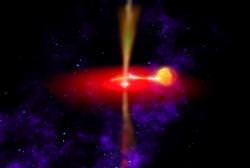It might sound surprising, but one of the most difficult tasks astronomers have is determining the mass of objects. It takes a binary system, where two stars or orbiting one another, to be able to make an accurate mass calculation. And determining the mass of black holes is even more difficult because they’re invisible.
But the clever astronomers have figured out a way, by measuring the location of the swirling accretion disk of material waiting to be consumed around a black hole. Since material can pile up faster than the black hole can consume it, it compresses together, heats up, and emits radiation that astronomers can detect. Researchers have discovered that there is a direct relationship between a black hole and the size of its surrounding accretion disk. Astronomers have calculated that this hot gas piles up in a location that scales up with the mass of the black hole. The more massive the black hole, the farther out the congestion occurs.
This technique has helped astronomers identify likely intermediate black holes, which contain thousand of times the mass of the Sun. Much more than a stellar mass black hole, but much less than the hundreds of millions of suns worth of mass in supermassive black holes.
Original Source: ESA News Release

